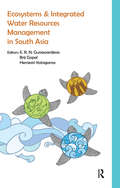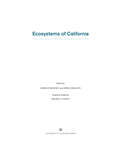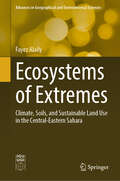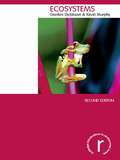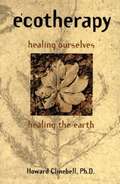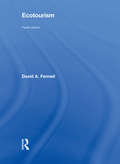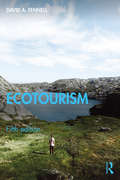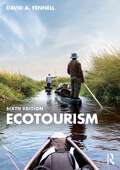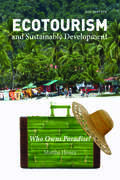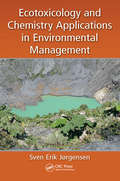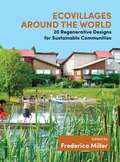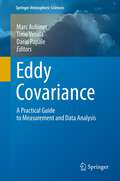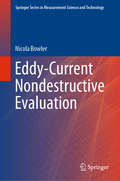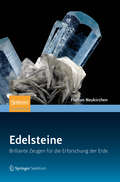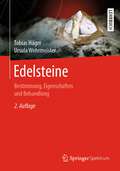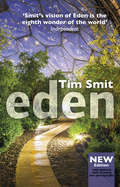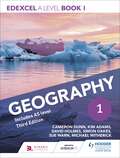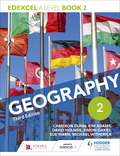- Table View
- List View
Ecosystems and Integrated Water Resources Management in South Asia
by E. R. N. Gunawardena; Brij Gopal; Hemesiri KotagamaThis book provides an ecosystem perspective in addressing the water resource management issues in the South Asian region. It argues that aspects such as sources of water, its distribution and users; land–water interrelations; drivers of change such as laws, policies and institutions; management of issues and technologies related to water supply; institutional set-up; economic instruments such as pricing, taxes, subsidies; and economics of ecosystem services are crucial. Climate changes, melting of glaciers and polar ice caps, rising sea level and the increased frequency of extreme events, have to be factored into integrated management of water resources. This book addresses some of these major issues related to aquatic ecosystems and focuses on three major aspects: (a) concepts related to ecosystems, ecosystem services and their linkages with water; (b) human impacts on ecosystems, particularly the aquatic ecosystems, and their assessment; and (c) the management, including policy, governance and economics. Comprising new theories, research and case studies, the book will be useful those concerned with water resource management – professionals, students and researchers.
Ecosystems of California
by Harold Mooney Erika ZavaletaThis long-anticipated reference and sourcebook for California's remarkable ecological abundance provides an integrated assessment of each major ecosystem type--its distribution, structure, function, and management. A comprehensive synthesis of our knowledge about this biologically diverse state, Ecosystems of California covers the state from oceans to mountaintops using multiple lenses: past and present, flora and fauna, aquatic and terrestrial, natural and managed. Each chapter evaluates natural processes for a specific ecosystem, describes drivers of change, and discusses how that ecosystem may be altered in the future. This book also explores the drivers of California's ecological patterns and the history of the state's various ecosystems, outlining how the challenges of climate change and invasive species and opportunities for regulation and stewardship could potentially affect the state's ecosystems. The text explicitly incorporates both human impacts and conservation and restoration efforts and shows how ecosystems support human well-being. Edited by two esteemed ecosystem ecologists and with overviews by leading experts on each ecosystem, this definitive work will be indispensable for natural resource management and conservation professionals as well as for undergraduate or graduate students of California's environment and curious naturalists.
Ecosystems of Extremes: Climate, Soils, and Sustainable Land Use in the Central-Eastern Sahara (Advances in Geographical and Environmental Sciences)
by Fayez AlailyThis book explores the environmental conditions, particularly the climate and soils, of one of the driest regions on earth, the Central-East of the Sahara. These factors control the ecosystems and determine the land's suitability for use. The area receives only 0.5 mm of precipitation annually and contains one of the largest aquifers in the Sahara, with fossil groundwater. The region's lithology includes Cretaceous formations and crystalline rocks, largely covered by quaternary sediments. Exogenous activities have shaped various landscape types, such as ergs with different dunes, deflated depressions with playas, and yardangs. Soils in the region are primarily formed through physical processes and are often shallow, sandy, and enriched with soluble salts. The book provides a detailed analysis of their physical and chemical properties, genesis, and relation to environmental factors and sociological aspects. It also discusses rare ecosystems, including those dependent on food imports and those that arise episodically and last for a few years. Considering all ecological parameters, a land assessment system for irrigated agriculture is developed, along with descriptions of suitable cultivation methods and optimal irrigation systems. The book's contents are based on data from several expeditions and laboratory work funded by the German Research Foundation.
Ecosystems: A Functional Approach (Routledge Introductions to Environment: Environmental Science)
by Kevin Murphy Gordon DickinsonIn examining both theory and applications, this book, through useful examples, provides a stimulating introduction to ecosystems. It examines the nature, types and characteristics of ecosystems as well as investigating the interactions between various systems and human actions. Using functional ecology as the basis for applying the ecosystem concept in contemporary environmental science and ecology, this second edition of this highly successful volume has been updated to reflect the latest research. It incorporates a strengthened theme in the use of functional ecology in explaining how ecosystems work and how the ecosystem concept may be used in science and applied science, and coverage of the interactions between humans and ecosystems has been substantially bolstered with the addition of chapters on human impacts and large scale impacts on ecosystems, and global environmental change and the consequences for ecosystems.Presented in a student-friendly format, this book features boxed definitions, examples, case studies, summary points, discussion questions and annotated further reading lists. It provides a concise and accessible synthesis of both ecosystem theory and its applications, and will be a valuable resource for students of environmental studies, ecology and geography.
Ecotherapy: Healing Ourselves, Healing the Earth
by Robert AndersonHere is a trailblazing book on issues of vital interest to the future of humankind. Ecotherapy: Healing Ourselves, Healing the Earth sheds light on humankind’s most serious health challenge ever--how to save our precious planet as a clean, viable habitat. As a guide for therapists, health professionals, pastoral counselors, teachers, medical healers, and especially parents, Ecotherapy: Healing Ourselves, Healing the Earth highlights readers’strategic opportunities to help our endangered human species cope constructively with the unprecedented challenge of saving a healthful planet for future generations. <p><p> Ecotherapy: Healing Ourselves, Healing the Earth introduces readers to an innovative approach to ecologically-grounded personality theory, spirituality, ecotherapy, and education. The book shares the author’s well-developed theories and methods of ecological diagnosis, treatment, and education so professionals and parents, our most influential teachers, can rise to the challenge of saving our planet. <p> A systematic theory and practice guidebook, Ecotherapy: Healing Ourselves, Healing the Earth fills a wide gap in both the counseling and therapy literature and the ecology literature. It offers an innovative model for fulfilling the “ecological circle” between humans and nature with three action dimensions. These are self-care by being intentionally nurtured by nature; spiritual enrichment by enjoying the transcendent Spirit in nature; and responding by nurturing nature more responsibly and lovingly. <p> The theories and practical applications presented in the book come together to explore long-overlooked issues at the boundary between human health and the health of the natural environment. Psychotherapists, health professionals, and teachers; pastoral counselors and other clergy who counsel and teach; laypersons who are parents and grandparents; and individuals and groups interested in environmental issues will find Ecotherapy: Healing Ourselves, Healing the Earth essential for approaching the long-neglected earthy roots of the total human mind-body-spirit organism.
Ecothrifty: Cheaper, Greener Choices for a Happier, Healthier Life (Mother Earth News Books for Wiser Living)
by Deborah NiemannA guide to saving a fortune while saving the Earth, from the author of Homegrown & Handmade. Use it up, wear it out, make it do, or do without. Our grandmothers knew the importance of responsible, thrifty choices. But somewhere along the way we lost our way and succumbed to the belief that we can get everything for next to nothing, have it shipped halfway around the world and then—more often than not—just throw it away. This consumer binge is taking its toll. Diet and lifestyle-related illnesses are epidemic, our environment is awash in a sea of plastic, our climate is changing, and the cost of everything is skyrocketing with the price of oil. Are we doomed? No. We can make greener, healthier choices, and we can do it while saving money. Where to start? Ecothrifty is packed with simple, practical ideas and recipes to help you:· Make homemade products for cleaning and skin care · Grow your own food and cook more from scratch · Raise your family without lowering your standards A must-read for anyone who has ever wanted to live a greener life but thought that it would be too expensive, time-consuming, or difficult, this handy, complete guide will show you how small changes can have a huge environmental impact and save you thousands of dollars, all while improving your quality of life.&“I support and endorse this wonderful book, 100%!&” —Ed Begley, Jr., actor and environmentalist&“Her advice does not come across as self-righteous or preachy, but more like insider tips from an experienced do-it-yourselfer.&” —Publishers Weekly
Ecotopia 2121: A Vision for Our Future Green Utopia?in 100 Cities
by Alan MarshallA 2016 Green Book Festival "Future Forecasts" WinnerA stunningly original, lushly illustrated vision for a Green Utopia, published on the 500th anniversary of the original Big Idea.Five hundred years ago a powerful new word was unleashed upon the world when Thomas More published his book Utopia, about an island paradise far away from his troubled land. It was an instant hit, and the literati across Europe couldn't get enough of its blend of social fantasy with a deep desire for a better world. Five hundred years later, Ecotopia 2121 once again harnesses the power of the utopian imagination to confront our current problems, among them climate change, and offer a radical, alternative vision for the future of our troubled planet.Depicting one hundred cities around the globe-from New York to San Francisco, London, Tokyo, Sydney, Rio de Janeiro, Mexico City, Beijing, Vienna, Singapore, Cape Town, Abu Dhabi, and Mumbai-Alan Marshall imagines how each may survive and prosper. A striking, full-color scenario painting illustrates each city. The chapters tell how each community has found either a social or technological innovation to solve today's crises. Fifteen American cities are covered. Around the world, urban planners like to tailor scenarios for the year 2020, to take advantage of the metaphor of 20-20 vision. In Ecotopia 2121, the vision may be fuzzy, but its sharp insights, captivating illustrations, and playful storytelling will keep readers coming back again and again.
Ecotourism
by David A. FennellEcotourism continues to be embraced as the antithesis of mass tourism because of its promise of achieving sustainability through conservation mindedness, community development, education and learning, and the promotion of nature based activities that were sensitive to both ecological and social systems. The extent to which this promise has been realised is open to debate. Focusing on an array of economic, social and ecological inconsistencies that continue to plague ecotourism in theory and practice, the volume examines ecotourism in reference to other related forms of tourism, impacts, conservation, sustainability, education and interpretation, policy and governance, and the ethical imperative of ecotourism as these apply to the world’s greenest form of tourism. Ecotourism is a growing field attracting increasing attention from students and academics. Fennell provides an authoritative and comprehensive review of the most important issues that continue to both plague ecotourism and make it one of the most dynamic sectors in the tourism industry. It covers a comprehensive range of themes and geographical regions. Building on the success of prior editions, Ecotourism has been revised throughout to incorporate recent research and benefits from the introduction of real-life case studies and summaries of recent literature. An essential reference for those interested in Ecotourism, the book is accessible to students but retains the depth required for use by researchers and practitioners in the field. New chapters on the theory and application of animal ethics; community development in sustainable tourism; and education and learning in the field have added further value to an already very comprehensive volume. This book will be of interest to students across a range of disciplines including geography, economics, business, ethics, biology, and environmental studies.
Ecotourism
by David A. FennellThe new fifth edition of Ecotourism focuses on an array of economic, social and ecological inconsistencies that continue to plague ecotourism in theory and practice, and examines the sector in reference to other related forms of tourism, impacts, conservation, sustainability, education and interpretation, policy and governance, and the ethical imperative of ecotourism as these apply to the world&’s greenest form of tourism. Building on the success of prior editions, the text has been revised throughout to incorporate recent research, including ecotourism taking place in under-represented world regions. It includes new case studies on important themes in research and practice as well as learning objectives in each chapter. David Fennell provides an authoritative and comprehensive review of the most important issues, including climate change and UN Sustainable Development Goals. Ecotourism continues to be embraced as the antithesis of mass tourism because of its promise of achieving sustainability through conservation mindedness, community development, education and learning, and the promotion of nature-based activities that are sensitive to both ecological and social systems. The book debates to what extent this promise has been realised. An essential reference for those interested in ecotourism, the book is accessible to students, but retains the depth required for use by researchers and practitioners in the field. This book will be of interest to students across a range of disciplines including geography, economics, business, ethics, biology, and environmental studies.
Ecotourism
by David A. FennellThe new sixth edition of Ecotourism focuses on an array of economic, social and ecological inconsistencies that continue to plague ecotourism in theory and practice, and examines the sector in reference to other related forms of tourism, impacts, conservation, sustainability, education and interpretation, policy and governance, and the ethical imperative of ecotourism as these apply to the world’s greenest form of tourism.Building on the success of prior editions, the text has been revised throughout to incorporate recent research, including ecotourism taking place in underrepresented world regions. It includes new case studies on important themes in research and practice as well as learning objectives in each chapter. David A. Fennell provides an authoritative and comprehensive review of the most important issues, including climate change and UN Sustainable Development Goals. Ecotourism continues to be embraced as the antithesis of mass tourism because of its promise of achieving sustainability through conservation mindedness, community development, education and learning, and the promotion of nature-based activities that are sensitive to both ecological and social systems. The book debates to what extent this promise has been realised.An essential reference for those interested in ecotourism, the book is accessible to students, but retains the depth required for use by researchers and practitioners in the field. This book will be of interest to students across a range of disciplines including geography, economics, business, ethics, biology, and environmental studies.
Ecotourism and Indonesia's Primates (Developments in Primatology: Progress and Prospects)
by Sharon L. Gursky Jatna Supriatna Angela AchornThe basic goal of the volume is to compile the most up to date research on the effect of ecotourism on Indonesia’s primates. The tremendous diversity of primates in Indonesia, in conjunction with the conservation issues facing the primates of this region, have created a crisis whereby many of Indonesia’s primates are threatened with extinction. Conservationists have developed the concept of “sustainable ecotourism” to fund conservation activities. National parks agencies worldwide receive as much as 84% of their funding from ecotourism. While ecotourism funds the majority of conservation activities, there have been very few studies that explore the effects of ecotourism on the habitat and species that they are designed to protect. It is the burgeoning use of “ecotourism” throughout Indonesia that has created a need for this volume where the successes and pitfalls at various sites can be identified and compared.
Ecotourism and Sustainable Development, Second Edition: Who Owns Paradise?
by Martha HoneyEcotourism and Sustainable Development is the most comprehensive overview of worldwide ecotourism available today, showing how both the concept and the reality have evolved over more than twenty-five years. Here Martha Honey revisits six nations she profiled in the first edition--the Galapagos Islands, Costa Rica, Tanzania, Zanzibar, Kenya, and South Africa--and adds a fascinating new chapter on the United States. She examines the growth of ecotourism within each country's tourism strategy, its political system, and its changing economic policies. Her useful case studies highlight the economic and cultural impacts of expanding tourism on indigenous populations as well as on ecosystems.
Ecotourism, NGOs and Development: A Critical Analysis (Contemporary Geographies of Leisure, Tourism and Mobility #Vol. 8)
by Jim ButcherEcotourism has emerged over the last twenty years not just as a market niche, but also as a strategy for combining development with conservation in the developing world. Ecotourism, NGOs and Development considers the basis for advocacy and argues that it is premised upon a very limited and limiting view of the potential for development. Jim Butcher examines the advocacy of tourism as sustainable development in a range of NGOs and within the general literature. The research reveals that in spite of the plethora of critical commentaries on the operation of ecotourism projects, there is generally an uncritical take on the ideological basis of the projects. This book offers a timely critique of key assumptions underlying ecotourism's status as sustainable development, arguing that ecotourism as development strategy ties the fate of some of the poorest people on the planet to localized environmental imperatives.
Ecotoxicology and Chemistry Applications in Environmental Management (Applied Ecology and Environmental Management)
by Sven Erik JorgensenEcotoxicology and Chemistry Applications in Environmental Management describes how to set up an integrated, holistic approach to addressing ecotoxicological problems. It provides detailed explanations in answer to questions like "Why is it necessary to apply an integrated approach?" and "How does one apply an integrated environmental management approach?" Highlighted topics of the book include Environmental chemical calculations QSAR estimation methods Toxic substance interference with other environmental problems Using diagnostic ecological subdisciplines for solutions Cleaner production methods and technologies Environmental risk assessment Addressing one of the most difficult tasks today, this book provides a much-needed holistic view for translating scientific knowledge and research results into effective environmental management measures. Rooted in a seven-step method, it integrates examination and quantification of an environmental problem and describes the use of ecological diagnostic tools to develop a diagnosis for ecosystem health. It also presents methods for choosing and using solutions or combinations of solutions to tackle problems.
Ecotoxicology: Perspectives on Key Issues
by Rachel Ann Hauser-Davis Thiago Estevam ParenteThis book presents an integrated discussion on ecotoxicology, containing both general concepts and specific ecotoxicological issues of major biological groups, extending beyond conventional systems. It explores worldwide, regional, and biocompartmentalized topics, bringing forth new points of view on global issues and addressing the increasing diversity and complexity of the ecotoxicological field. It also contains novel information on emerging contaminants, presents bioaccumulation effects on different levels of ecological organization and risk analyses, and discusses novel fields of methodological applications, including key aspects in ecotoxicological and environmental monitoring studies.
Ecovillages and Ecocities: Bioclimatic Applications from Tirana, Albania (The Urban Book Series)
by Klodjan XhexhiEcological and livable cities need an objective method to be examined. This book is in search of a method to determine the level of livability, ecology and energy efficiency. Ecological and sustainable cities need to properly make up for the existent weakness of the city's construction under fine ecological environment. The intention of this comparative study is an attempt to improve life quality in Tirana, Albania. It gives examples of successful strategies, e.g. bioclimatic solution through passive solar systems and the use of underground tunnels. This book is aimed at researches, professionals, architects and city planners.
Ecovillages around the World: 20 Regenerative Designs for Sustainable Communities
by Frederica Miller<p>Aligning perfectly with the practices of ecovillages around the world, these initiatives show that ecovillages and sustainable communities are leading by example as we move into a future focused on partnership, environmental protection, prosperity, and peace for all life and the planet we live on. <p>Offering a visual tribute to the work ecovillages do to alleviate climate change, social conflict, and environmental damage, including more than 300 full-color photographs, maps, and diagrams, this beautiful book highlights 20 best practice designs from ecovillages around the world to show how we can live lightly on the planet no matter where on earth we live, in all climate zones and cultures. It demonstrates how ecovillages have already achieved the climate goals all of us are now striving toward through practical lifestyle changes that promote peaceful and joyful coexistence both among people and between people and nature. Far from being only aesthetic choices, these changes give an increased quality of life, healthy homes, delicious organic food, playful interdependence, a new spiritual connection to our living planet, and much more. Through their regenerative, sustainable, and peace-promoting practices, ecovillages continue the culture of traditional village living in a modern way that addresses the critical challenges of our time. <p>The book features the following 20 ecovillage projects: Hurdal Ecovillage and Hurdal Sustainable Valley, Norway; Svanholm, Denmark; Permatopia, Denmark; Solheimar, Iceland; Lilleoru, Tallin, Estonia; Findhorn, Scotland; Sieben Linden, Germany; Tamera, Portugal; Damanhur, Italy; Torri Superiore, Italy; Kibbutz Lotan, Israel; Sekem, Egypt; Chololo, Tanzania; Tasman Ecovillage, Australia; Narara, Australia; Hua Tao Ecovillage, China; Auroville, India; Ecovillage at Ithaca, New York, USA; Huehuecoyotl, Mexico; Ceo do Mapia, Brazil.
Eddy Covariance
by Dario Papale Timo Vesala Marc AubinetThis highly practical handbook is an exhaustive treatment of eddy covariance measurement that will be of keen interest to scientists who are not necessarily specialists in micrometeorology. The chapters cover measuring fluxes using eddy covariance technique, from the tower installation and system dimensioning to data collection, correction and analysis. With a state-of-the-art perspective, the authors examine the latest techniques and address the most up-to-date methods for data processing and quality control. The chapters provide answers to data treatment problems including data filtering, footprint analysis, data gap filling, uncertainty evaluation, and flux separation, among others. The authors cover the application of measurement techniques in different ecosystems such as forest, crops, grassland, wetland, lakes and rivers, and urban areas, highlighting peculiarities, specific practices and methods to be considered. The book also covers what to do when you have all your data, summarizing the objectives of a database as well as using case studies of the CarboEurope and FLUXNET databases to demonstrate the way they should be maintained and managed. Policies for data use, exchange and publication are also discussed and proposed. This one compendium is a valuable source of information on eddy covariance measurement that allows readers to make rational and relevant choices in positioning, dimensioning, installing and maintaining an eddy covariance site; collecting, treating, correcting and analyzing eddy covariance data; and scaling up eddy flux measurements to annual scale and evaluating their uncertainty.
Eddy-Current Nondestructive Evaluation (Springer Series in Measurement Science and Technology)
by Nicola BowlerThis book covers the topic of eddy current nondestructive evaluation, the most commonly practiced method of electromagnetic nondestructive evaluation (NDE). It emphasizes a clear presentation of the concepts, laws and relationships of electricity and magnetism upon which eddy current inspection methods are founded. The chapters include material on signals obtained using many common eddy current probe types in various testing environments. Introductory mathematical and physical concepts in electromagnetism are introduced in sufficient detail and summarized in the Appendices for easy reference. Worked examples and simple calculations that can be done by hand are distributed throughout the text. These and more complex end-of-chapter examples and assignments are designed to impart a working knowledge of the connection between electromagnetic theory and the practical measurements described. The book is intended to equip readers with sufficient knowledge to optimize routine eddy current NDE inspections, or design new ones. It is useful for graduate engineers and scientists seeking a deeper understanding of electromagnetic methods of NDE than can be found in a guide for practitioners.
Edelsteine
by Florian NeukirchenWie entstehen Edelsteine? Wo gibt es sie? Und was können wir von ihnen lernen? Bei der Bildung von Smaragd, Rubin, Diamant, Topas oder Opal sind die beteiligten Zutaten und Prozesse so vielfältig wie die Edelsteine selbst. Während beispielsweise die Riesenkristalle eines Pegmatits innerhalb von Tagen wachsen, dauert die Entstehung von Amethystgeoden einige Millionen Jahre. Anschaulich erklärt Florian Neukirchen, wie seltene Elemente angereichert werden und wie es zu ungewöhnlichen Begegnungen zwischen Spurenelementen kommt. Diamanten verdanken wir nicht nur einiges Wissen über den Erdmantel, sondern auch über die Entstehung der ersten Kontinente. Bei ihrer Bildung spielen Redoxreaktionen im Erdmantel eine ähnlich wichtige Rolle wie ungewöhnlich ablaufende Vulkaneruptionen, durch die sie sicher an die Oberfläche gebracht werden, ohne zu verbrennen. Edelsteine erzählen uns manch erstaunliche Geschichte: Wie eine Kapsel, die geheime Dokumente birgt, enthalten sie Informationen über unzugängliche Regionen der Erde aus einer fernen Vergangenheit und sogar aus der Tiefe des Weltalls: In Meteoriten wurden Diamanten gefunden, die sogar älter als das Sonnensystem sind. Granate dienen Forschern als eine Art Thermometer, da sie die Bildungstemperatur eines Gesteins anzeigen. Einige Zirkonkristalle sind die einzigen Zeugen aus der höllisch heißen Frühzeit der Erde, aus der keine Gesteine erhalten sind. Die winzigen Kristalle ermöglichen uns sogar Aussagen über das damalige Klima. Abgerundet wird das Buch mit Informationen über Minen, Märkte und antike Handelsrouten und einem Kapitel über die technische Anwendung und synthetische Herstellung von Edelsteinen.
Edelsteine: Bestimmung, Eigenschaften und Behandlung
by Tobias Häger Ursula WehrmeisterDas Buch gibt einen anschaulichen Überblick über das facettenreiche Gebiet der Gemmologie in Theorie und Praxis. Im ersten Teil werden die klassischen und modernen Methoden zur Bestimmung und Erkennung der Edelsteine ausführlich vorgestellt. Der zweite Teil des Buches umfasst den komplexen Bereich der Manipulationen und Behandlung der Schmuckmaterialien sowie ihre Erkennungsmöglichkeiten. Die Kapitel des letzten Teils widmen sich den Grundlagen zum besseren Verständnis der Eigenschaften und Methoden.
Eden: Updated 15th Anniversary Edition
by Tim Smit'Smit's vision of Eden is the eighth wonder of the world' Independent'Inspiring... An invaluable guide to how a large project can exceed against all odds' The Sunday Times-An updated edition of the bestselling story of the Eden Project featuring stunning new photography.At the beginning of the twenty-first century, the impossible was delivered. From the sterile depths of a disused china clay pit in Cornwall rose one of the most remarkable and ambitious ventures in recent memory. The Eden Project's Biomes, the world's largest conservatories, are the symbol of a living theatre of plants and people and their interdependence, of regeneration and of a pioneering forum for the exploration of possible futures.This is the extraordinary story of the Eden Project, of its conception, design and construction, of the larger-than-life personalities who made it happen and of all that has happened since its doors were first opened to the public in 2001. It is now undisputedly one of the world's great gardens with more than 17 million visitors flocking there and projects and partnerships all over the world.
Edexcel A level Geography Book 1
by Cameron Dunn David Holmes Kim AdamsEndorsed for EdexcelTrust the leading A level Geography publisher to boost your students' geographical knowledge and skills with a fully updated edition of our bestselling Student's Book; designed to provide the in-depth subject coverage, developmental activities and exam support you need at a time of curriculum change.- Helps students acquire, apply and revise core knowledge using clear explanations of key geographical content and concepts- Progressively builds the geographical and data skills emphasised in the 2016 specification by offering plenty of opportunities to learn and practise relevant skills for each topic- Brings geographical theory to life with a bank of engaging, up-to-date case studies, examples and place contexts- Consolidates topic knowledge and enables students to track their learning with review questions at the end of each chapter- Prepares students for the demands of AS and A level examinations by including numerous exam-style questions, ideal for skills development and rolling revision throughout the course- Makes it easier for you to meet the increased fieldwork requirements, suggesting topic-focused enquiries for both physical and human geography
Edexcel A level Geography Book 1 Third Edition
by Sue Warn Cameron Dunn Simon Oakes David Holmes Michael Witherick Kim AdamsExam Board: EdexcelLevel: AS/A-levelSubject: GeographyFirst Teaching: September 2016First Exam: June 2017Endorsed for Edexcel.Trust the leading A level Geography publisher to boost your students' geographical knowledge and skills with a fully updated edition of our bestselling Student's Book; designed to provide the in-depth subject coverage, developmental activities and exam support you need at a time of curriculum change.- Helps students acquire, apply and revise core knowledge using clear explanations of key geographical content and concepts- Progressively builds the geographical and data skills emphasised in the 2016 specification by offering plenty of opportunities to learn and practise relevant skills for each topic- Brings geographical theory to life with a bank of engaging, up-to-date case studies, examples and place contexts- Consolidates topic knowledge and enables students to track their learning with review questions at the end of each chapter- Prepares students for the demands of AS and A level examinations by including numerous exam-style questions, ideal for skills development and rolling revision throughout the course- Makes it easier for you to meet the increased fieldwork requirements, suggesting topic-focused enquiries for both physical and human geography
Edexcel A level Geography Book 2 Third Edition
by Cameron Dunn David Holmes Kim AdamsEndorsed for EdexcelTrust the leading A level Geography publisher to boost your students' geographical knowledge and skills with a fully updated edition of our bestselling Student's Book; designed to provide the in-depth subject coverage, developmental activities and exam support you need at a time of curriculum change.- Helps students acquire, apply and revise core knowledge using clear explanations of key geographical content and concepts- Progressively builds the geographical and data skills emphasised in the 2016 specification by offering plenty of opportunities to learn and practise relevant skills for each topic- Brings geographical theory to life with a bank of engaging, up-to-date case studies, examples and place contexts- Consolidates topic knowledge and enables students to track their learning with review questions at the end of each chapter- Prepares students for the demands of AS and A level examinations by including numerous exam-style questions, ideal for skills development and rolling revision throughout the course- Makes it easier for you to meet the increased fieldwork requirements, suggesting topic-focused enquiries for both physical and human geography
